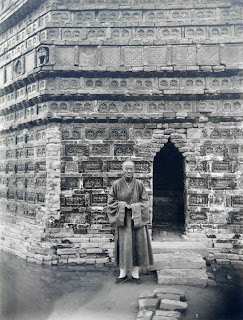 |
| Priest at the Iron Pagoda, Kaifeng Photograph by Yü Tai, 1910 The Charles Lang Freer papers, neg.#34 |
Many collections in the Archives contain journals, diaries, albums and reports based on individual travels. When multiple travelers visit the same site over a period of years, they provide scholars a useful range of impressions. Here are two passages describing the same location, the first by Charles Freer who visited Kaifeng in 1910, and another by the art historian Langdon Warner in 1913.
Freer:
Freer:
“Saturday P.M. – visited Iron Pagoda. Priest said built during late Tang and Five Dynasties and repairs made and the prominent yellow tiles with seated Buddhas were placed in the openings by the first Ming Emperor Hung wu, 1368 to 1399. Name of priest (Fan Ming Tun-ger, Buddhist priest family name) now 70 years old – began in this temple when a boy 9 years old and has never since been outside of Kai Feng Fu nor out of sight of the pagoda. This pagoda is very beautiful seen nearby or from a distance. Its low toned colors are very fine and at a distance resemble ancient iron with exquisite patinas. Just within its small entrance doors is seen an unimportant seated Buddha – probably Chin, of plaster, but the early decorated tiles covering the walls of the little room are charming.”
 |
| Kaifeng, Iron Pagoda Photographs by Langdon Warner, 1913 From The Warner Report, Gift of Katherine Graham, 1994. Part I, page 105. |
“The “iron pagoda” (T’ieh T’a) erected in A.D. 1383 stands among the ruins of a temple of which it was a part. It is encrusted with glazed tiles moulded in relief and colored rich brown, green, red and yellow. From a distance the blend of these colors suggests rusty iron. The tower is thirteen stories high and is octagonal, each face measuring m. 4.15 at a height of about four feet from the ground. In the faces toward the four cardinal points are small chapels (bricked up), that on the East containing four Ming (?) iron statues, and a glazed tile bearing and incrustation which could not be examined. “
With the kind assistance of volunteers, I am currently transcribing and cataloging Freer’s journals and diaries from his journey to Longmen which, in conjunction with the outstanding images taken by his Chinese photographer Yü Tai, will bring to light a previously unrecognized, but enormously valuable resource.
-- David Hogge, Freer Gallery of Art and Arthur M. Sackler Gallery Archives
-- David Hogge, Freer Gallery of Art and Arthur M. Sackler Gallery Archives







No comments:
Post a Comment